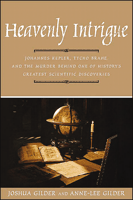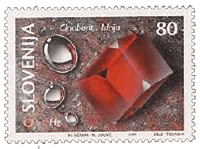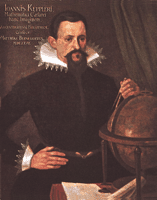Cloud About Mercury
- Joan Cmarik earned a BS in chemistry and biology from Murray State University and spent a year at the National Center for Toxicological Research. She earned a PhD, as a University Fellow, in the Department of Biochemistry and the Center in Molecular Toxicology at Vanderbilt University. Currently, she is a staff scientist at the National Cancer Institute in Frederick, Maryland.

Heavenly Intrigue
Joshua Gilder and Anne-Lee Gilder.
New York: Doubleday; 2004. 320 pages. $24.95, ISBN: 0385508441
Johannes Kepler is firmly established in the pantheon of great astronomers whose contributions not only brought scientific rigor to a discipline fraught with divination but also profoundly altered our perception of who we are in relation to everything else in the universe. Kepler is most renowned for his three laws of planetary motion, including the description of the orbits of the planets as elliptical with the sun at one focus of the ellipse—a major change from the previously proposed circular orbits that Kepler had set out to prove.
The name of Tycho Brahe, however, may be less familiar, despite his being undoubtedly the most famous astronomer of his time. His chance for an equivalent place in history may have been cut short by his untimely death, or, as Joshua and Anne-Lee Gilder would argue…by his murder.
The crux of the matter seems to be access to Brahe’s astronomical observations of the planets and the stars, collected in astonishing detail over the course of forty years. Brahe, twenty-five years older than Kepler, has been portrayed as withholding his data from Kepler because of jealousy of the younger man’s brilliance. Heavenly Intrigue, however, offers an alternative interpretation: in the face of Brahe’s understandable reluctance to release his data until it had been analyzed and his own conclusions published, Kepler became obsessed with the desire to have access to all of Brahe’s data for his own purposes.

But was Kepler obsessed enough to commit murder to achieve his goals? The Gilders reply with a resounding “Yes!” In their thoroughly researched book, the authors build a careful case to establish means, motive, and opportunity. The first several chapters painstakingly establish the character of the leads in this evolving murder plot. The text abounds with direct quotations of Brahe, Kepler, and some of their contemporaries that provide a fascinating glimpse into their times, thoughts, and personalities. These striking comments from Brahe reveal some of his own guiding principles:
“Let others compliment themselves on their high birth and look for honor in the deeds of their ancestors’ or seek the favor of kings and dukes…. And although I carry as well the name of a distinguished noble tribe, from the Brahes and the Billes, such does not affect me. Because what we haven’t done ourselves, but derive from our origins and ancestors, that I call not ours. For myself, I aspire to higher things.’”

We are left with a view of Brahe as a careful scientific observer and a concerned and kind mentor, paired with that of Kepler as an ambitious, frustrated, and basically unhappy genius. The plot thickens with descriptions of their interactions, culminating in more than one stormy confrontation—but oddly enough, Brahe always seems willing to forgive and forget, and continues to offer Kepler his support. One such occasion follows Kepler’s sojourn to Styria in 1601 on family business. Upon Kepler’s return, Brahe assigned him what Kepler considered to be the tedious task of using Brahe’s observations to generate a new set of tables of celestial motion (used to predict astronomical events) that would require years of mathematical calculations. It is not long thereafter that Brahe attends a banquet that marks the onset of the illness that would take his life. Companions later noted that he held his urine longer than usual; upon his return home he was feverish and unable to urinate. Twelve days later, on 24 October, 1601, Brahe died. Despite Brahe’s bequeathal of his logbooks of copious data to his family, Kepler managed to obtain them and used the data, especially that on Mars, to develop his laws of planetary motion, and the rest is history.
Fast forward to 1991, when a piece of Brahe’s hair is subjected to atomic absorption spectroscopy. The resulting spectra reflected high levels of mercury, strongly indicative of poisoning. The symptoms resulting from a large dose of mercury are rapid in onset and include oliguric renal failure (causing a reduction in urine and concomitant build-up of toxins) and painful inflammation of the gastroinstestinal tract, which can be so severe it results in perforation of the intestinal lining leading to infection and fever—exactly those symptoms recorded as experienced by Brahe. Further evidence for mercury poisoning came in 1996 from a particle-induced X-ray emission (PIXE) analysis of Brahe’s moustache hair. This analytical method is able to pinpoint not only the elements present but also their location within a sample. The PIXE analysis provided irrefutable evidence of poisoning and even revealed the time at which Brahe was poisoned. After ruling out an accidental poisoning, the Gilders argue convincingly that Kepler was the only likely suspect with the opportunity, the means, and the motive to poison his perceived nemesis.


Although as mysteries go this historical account can’t be called a page-turner, the plot holds its own. The authors present an impressive body of facts and use illustrative analogies that convey complex astronomical concepts in lay terms. Along the way, the reader is encouraged to acknowledge the debt that modern science owes to Brahe: he was “one of the first great, systematic empirical thinkers, and a founder of the modern scientific method.” As an inventor, he designed instruments capable of the most accurate naked-eye astronomical observations yet, and he pioneered taking repeated measurements, with more than one instrument, to improve accuracy—such averaging of measurements is now considered a prerequisite for sound science. As a result, Brahe’s observations “were so extraordinarily precise it would take over a century until the telescope could surpass them in accuracy.” Brahe’s model of planetary orbits shattered the previously held concept that physical spheres kept the planets in position, begging the question of what force held the planets in their orbits and kept them in continual motion, opening the door onto the path that ultimately led to understanding gravitational force.
Did Johannes Kepler, through the act of intentional poisoning with mercury, murder the Imperial Mathematician of the Holy Roman Empire, Tycho Brahe? Strong but circumstantial evidence is presented. You, the reader, will have to decide.…
Footnotes
-
[Editor’s note: Lest you think, dear reader, that poisonings are solely the stuff of torpid mystery books or happened only in dimly lit corners of antiquity, one only need remember back to late 1978, when Georgi Markov, a Bulgarian dissident, was murdered in London by ricin housed in a platinum-iridium BB administered from an umbrella gun, or in late 2004, when the Ukrainian opposition candidate for president, Viktor Yushchenko, was poisoned with a dioxin derivative in the hope that his death would assure a pro-Russian candidate’s victory.]
- © American Society for Pharmacology and Experimental Theraputics 2005



